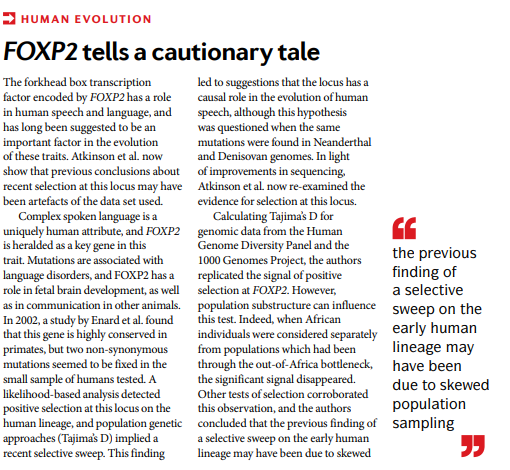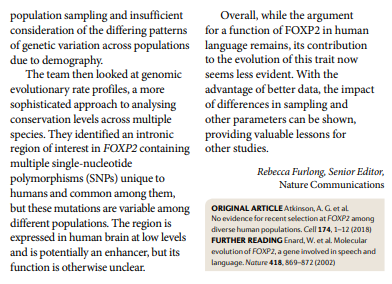You remembered correctly. The only gene we’re even found that facilitates language is the FoxP2 gene, and ours is identical to that of our Neanderthal cousins. They probably had the ability to speak. They differed from humans genetically in some aspects of creativity, however.
Ah, FoxP2. Yes and no. Turns out it’s not a “language gene” and may not be that crucial to human language acquisition. Here’s a recent article in Cell (2018) and explanatory review in Nature Reviews Genetics.
https://www.sciencedirect.com/science/article/pii/S0092867418308511


Yes on the fact that globularity involved a complex network involving a change in size and shape of the cerebellum, parietal and prefrontal lobes. All of those are involved in language, creativity, and “fluid” flow of information between all areas of the brain. It’s sort of like rewiring an old house.
Edit: Forgot to add, Neanderthal certainly spoke. They were more likely speaking an advanced form of protolanguage, though.
I should also add that the oldest H. sapiens from Jebel Irhoud dated 300,000 years ago has the small face of present-day humans but the elongated skull of archaic humans and Neanderthal. The first article I cited in post 40 surveyed all known sapiens fossil skulls from that point until 35,000 years ago and found that our distinctive “globe” didn’t start showing up until 100,000 years ago and didn’t evolve into its present form until 35,000 years ago.
For one thing, I never called FOXP2 a language gene. It has several functions, including facilitating human language. A mutation in the gene causes a speech disorder, and prevents children from using language correctly.
Your headline says,
“No Evidence for Recent Selection at FOXP2 among Diverse Human Populations.”
Yet I never claimed that it was recently selected for.
And read your second article carefully. it acknowledges a function for FOXP2 in human language.
So if you want to take issue with something I said, make sure I actually said it.
Do you ever look at Neanderthal fossils in a museum? At the American Museum of Natural History, You can view a Neanderthal, a human, and a chimp side by side, and see very clearly the differences and similarities. very cool.
@klw might like to learn about the role of FOXP2 in the songs of finches.
Thanks for the info about the FOXP2 gene. The neurobiology and development of bird song is really fascinating!
Any time, You know how sophisticated the songs of finches are, and how they learn them.
I wasn’t taking issue with anything you said. Just having a conversation and sharing some info. Y’all take care.
This topic was automatically closed 6 days after the last reply. New replies are no longer allowed.